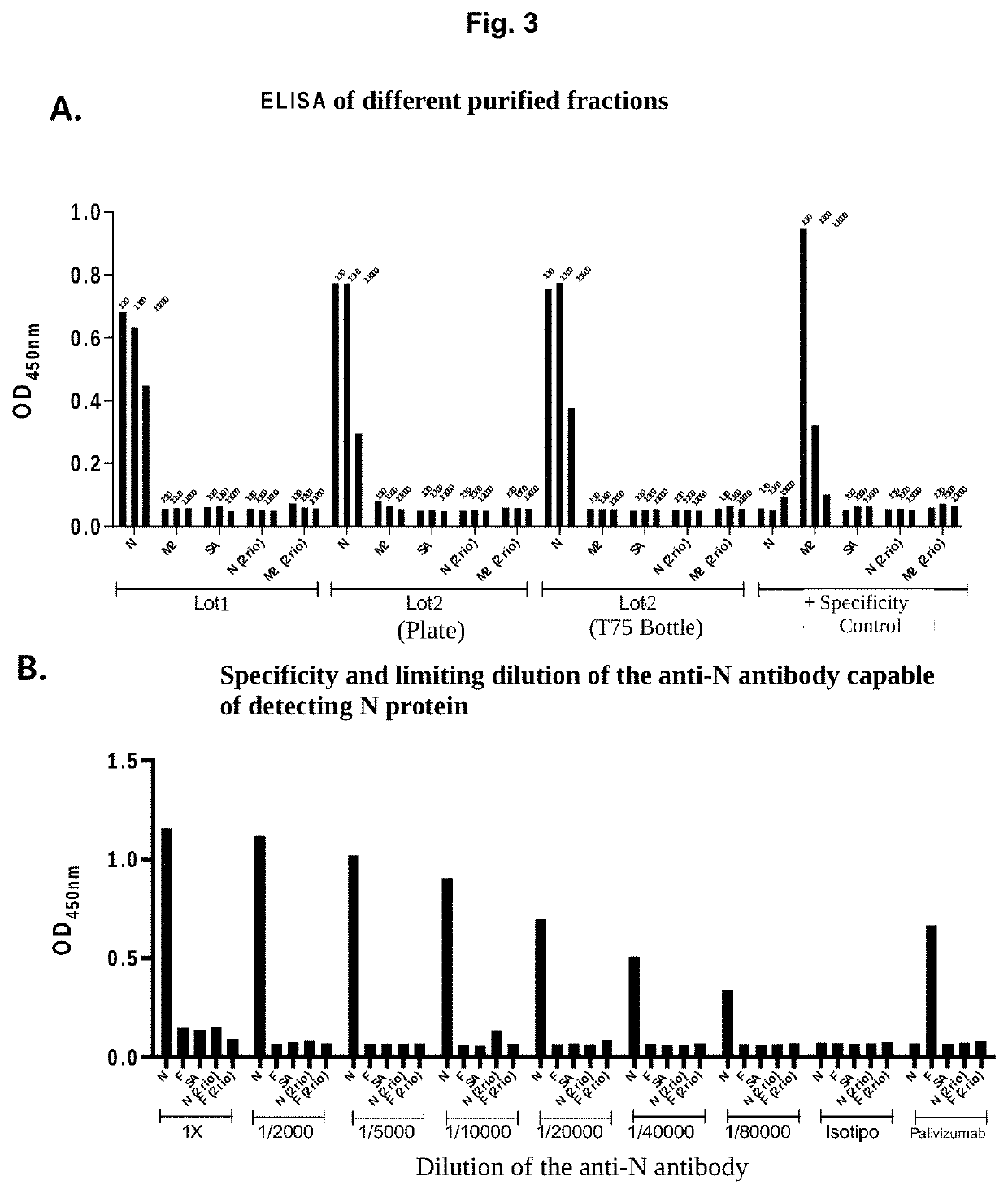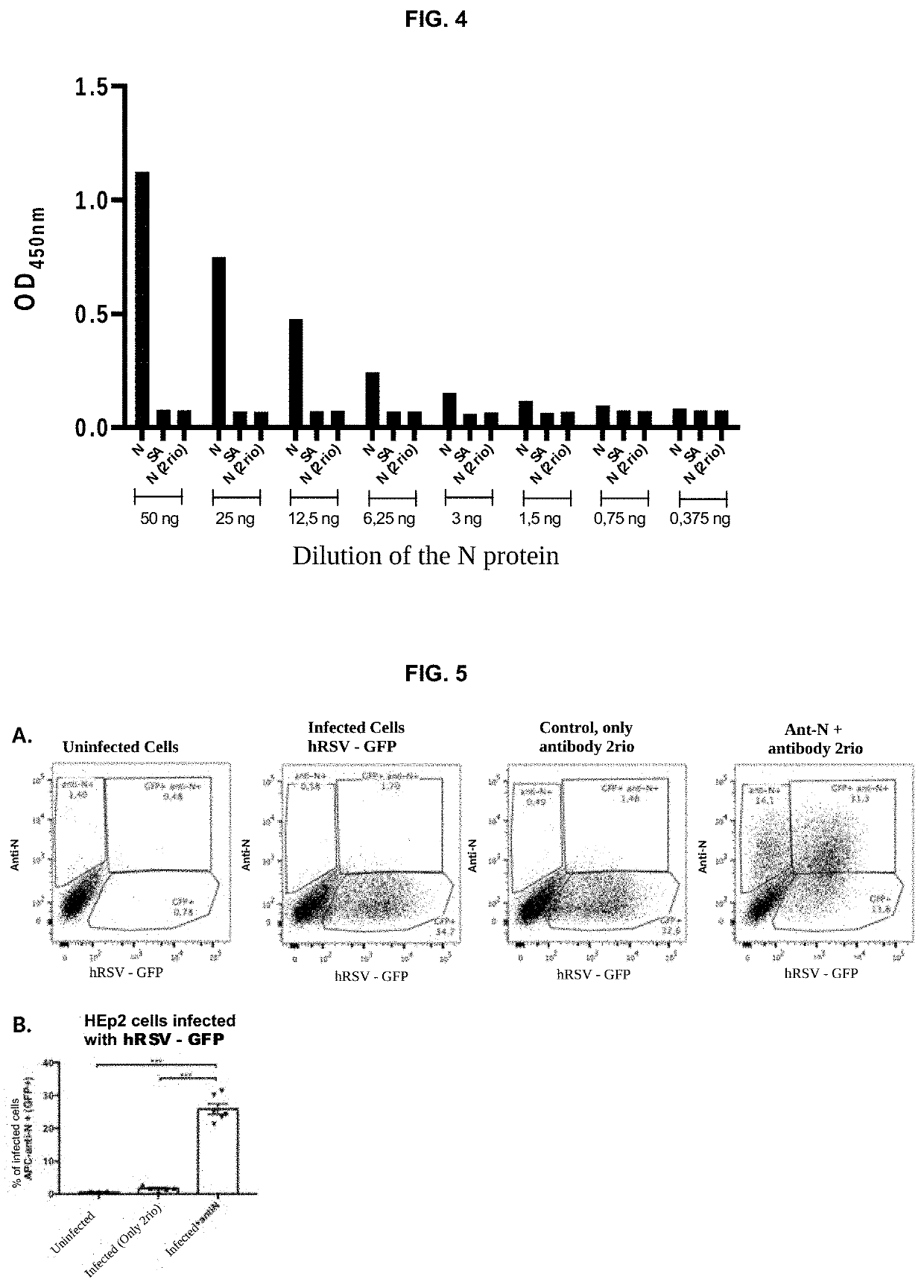Specific monoclonal antibody against the n antigen of human respiratory syncytial virus (HRSV) useful for treating infection, detection thereof and diagnosis
a human respiratory syncytial virus and monoclonal antibody technology, applied in the field of monoclonal antibodies, can solve the problems of frequent reinfection, severe outbreak, and decreased severity
- Summary
- Abstract
- Description
- Claims
- Application Information
AI Technical Summary
Problems solved by technology
Method used
Image
Examples
example 1
the Antibody of the Invention
[0031]The inventors obtained the secretory hybridoma of the anti-N monoclonal antibody. This hybridoma was cultured for about one month and a stable culture of the cells was obtained. From this stable culture, multiple aliquots corresponding to stocks stored at −150° C. were generated. The antibody of the invention was sequenced, and the sequences are disclosed in this patent. The sequence of the variable region of the heavy chain is found in SEQ ID No. 2, and the nucleotide sequence that encodes it is found in SEQ ID No. 1. Additionally, the sequence of the variable region of the light chain is found in SEQ ID No. 4, and the nucleotide sequence that encodes it is found in SEQ ID No. 3.
example 2
en Detection Assay, Anti-N Monoclonal Antibody Specificity for Purified RSV Antigens
[0032]An ELISA was performed to verify that the antibodies secreted by the hybridoma cells recognize the N protein of the hRSV. The plate was sensitized with N and F protein to evaluate the specificity of the antibody, as a control an inactivated plate was used, and plates with only the secondary antibody were also evaluated. As can be seen in FIG. 1, the antibodies of the invention, evaluated as the supernatants of the hybridomas (lot 1 and lot 2) are able to recognize only the N protein and do not recognize the F protein, which suggests a high Specificity of the antibody for the N protein. As indicated in the description of the figures, the antibody of the invention has a high recognition rate for the N protein, almost three times that of the positive control, polyclonal anti-N antibody. A second test was performed to evaluate the specificity of the antibody of the invention, using the dot blot tec...
example 3
Determine the Efficiency and Specificity of the Monoclonal Antibody to Detect Viral Antigens
[0033]After determining that the purified antibody recognizes the N protein of the hRSV, an ELISA was performed to ensure its specificity. In this ELISA, different concentrations of the primary antibodies were used and the concentration of the N protein was kept constant (50 ng). An α-M2 antibody that is directed against the viral protein M2 and a commercial anti-F antibody that is directed against the viral F protein was used as a specificity control. FIG. 3A shows that the antibody is capable of binding to the N protein, no signal observed in wells activated with protein M2 or without activation (SA). The antibodies of the invention were evaluated from 2 different productions, Lot 1 is a first purification. Lot 2 corresponds to a purification carried out later, where a hybridoma culture was simultaneously performed in a plate and in a T75 bottle. The results show a high efficiency of the An...
PUM
| Property | Measurement | Unit |
|---|---|---|
| pharmaceutical composition | aaaaa | aaaaa |
| affinity | aaaaa | aaaaa |
| fluorescent | aaaaa | aaaaa |
Abstract
Description
Claims
Application Information
 Login to view more
Login to view more - R&D Engineer
- R&D Manager
- IP Professional
- Industry Leading Data Capabilities
- Powerful AI technology
- Patent DNA Extraction
Browse by: Latest US Patents, China's latest patents, Technical Efficacy Thesaurus, Application Domain, Technology Topic.
© 2024 PatSnap. All rights reserved.Legal|Privacy policy|Modern Slavery Act Transparency Statement|Sitemap



